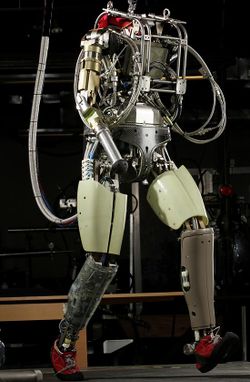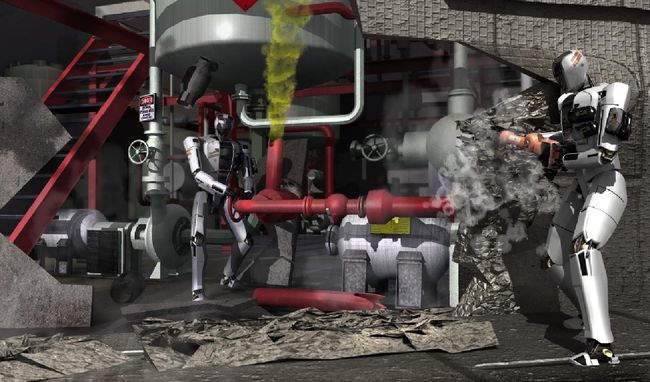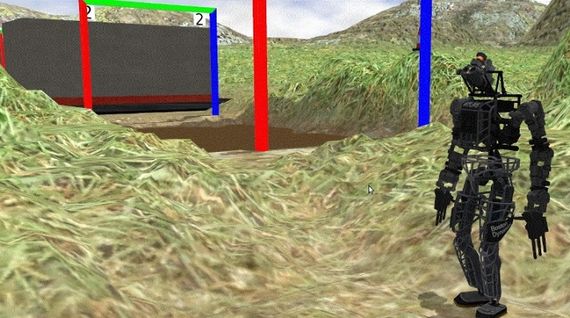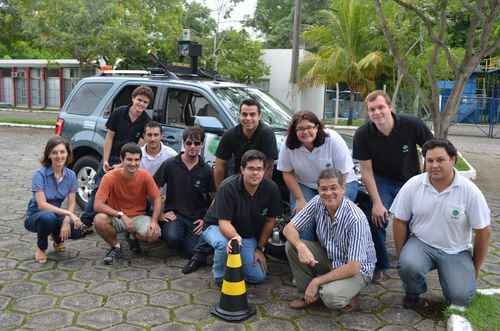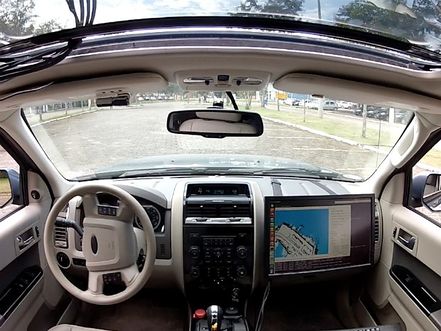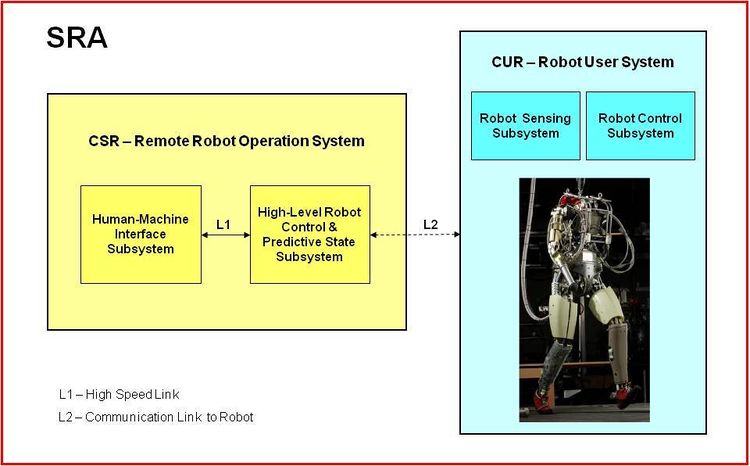Mudanças entre as edições de "DARPA"
| Linha 83: | Linha 83: | ||
== '''Our achievements''' == | == '''Our achievements''' == | ||
| − | The guys from Brazil did great in the VRC competition! The '''Br Robotics Team''' ranked #12 out of the 26 qualifiers. One can tell how tough is to join this smart club by reading the following tale. The U.S. Government invited 10 top-class teams from USA e one from Israel, and funded $375,000 each to develop robotic software and compete in DARPA's VRC. They were tagged Track B teams. Eventually only 10 Track B teams were successful in the qualifying process. These teams came from high-tech companies (Lockheed Martin, TRAC Labs, TORC Robotics, RE2), top-class universities (MIT, Carnegie Mellon, Washington, Ben-Gurion) and advanced research centers (NASA JPL, Florida IHMC). Over 100 non-funded teams had applied for the VRC competition, and they were tagged Track C teams. Only 16 Track C teams were successful in the qualifying process, telling how narrow was that funnel. These Track C teams came from universities and research organizations in USA and six other countries: Japan, UK, Spain, Poland, Brazil and Mexico. After a few weeks the 26 teams met at the VRC three-day competition, and tested their skills in simulated robotic locomotion and dexterity. The tasks were so hard that 4 out of the 26 qualified teams were unable to score at least once during the three days. The '''Br Robotics Team''' is glad to be skilled enough to score 16 times. Another remarkable achievement of our team is to overmatch the performance of 3 Track B funded teams. We ranked #5 out of the 16 Track C teams, standing behind only a couple of teams from USA and Japan. | + | The guys from Brazil did great in the VRC competition! The '''Br Robotics Team''' ranked #12 out of the 26 qualifiers. One can tell how tough is to join this smart club by reading the following tale. The U.S. Government invited 10 top-class teams from USA e one from Israel, and funded $375,000 each to develop robotic software and compete in DARPA's VRC. They were tagged Track B teams. Eventually only 10 Track B teams were successful in the qualifying process. These teams came from high-tech companies (Lockheed Martin, TRAC Labs, TORC Robotics, RE2), top-class universities (MIT, Carnegie Mellon, Washington, Ben-Gurion) and advanced research centers (NASA JPL, Florida IHMC). Over 100 non-funded teams had applied for the VRC competition, and they were tagged Track C teams. Only 16 Track C teams were successful in the qualifying process, telling how narrow was that funnel. These Track C teams came from universities and research organizations located in USA and six other countries: Japan, UK, Spain, Poland, Brazil and Mexico. After a few weeks the 26 teams met at the VRC three-day competition, and tested their skills in simulated robotic locomotion and dexterity. The tasks were so hard that 4 out of the 26 qualified teams were unable to score at least once during the three days. The '''Br Robotics Team''' is glad to be skilled enough to score 16 times. Another remarkable achievement of our team is to overmatch the performance of 3 Track B funded teams. We ranked #5 out of the 16 Track C teams, standing behind only a couple of teams from USA and Japan. |
([http://www.theroboticschallenge.com/local/documents/Scoreboard%20Final.pdf See the VRC Final Scoreboard]) | ([http://www.theroboticschallenge.com/local/documents/Scoreboard%20Final.pdf See the VRC Final Scoreboard]) | ||
Edição das 02h09min de 5 de julho de 2013
DARPA Robotics Challenge
Índice
What is DARPA?
The Defense Advanced Research Projects Agency (DARPA) is the U.S. Department of Defense (DoD) 's primary innovation engine. The Agency undertakes projects and scientific investigations aiming to create innovative technologies that address current practical problems. One of the focus areas of DARPA's Tactical Technology Office (TTO) is the development of unmanned systems to improve navigation in dynamic conditions, extend range and endurance, and increase adaptive autonomous operations. The DARPA Robotics Challenge (DRC) is all about that.
What is the DARPA Robotics Challenge?
Some natural or man-made disasters, due to grave risks to the health and wellbeing of rescue and aid workers, prove too great for timely and effective human response. The DARPA Robotics Challenge (DRC) intends to extend humanitarian aid to victims of disasters by promoting innovation in robotic technology for disaster-response operations.
The primary technical goal of the DRC is to develop ground robots capable of executing complex tasks in dangerous, degraded, human-engineered environments. Competitors in the DRC are expected to focus on robots that can use standard tools and equipment commonly available in human environments, ranging from hand tools to vehicles, with an emphasis on adaptability to tools with diverse specifications.
| Boston Dynamics Atlas robot | Robots performing some DRC tasks |
The robot competitions will comprise eight tasks:
- Enter an utility vehicle, drive it on a road, and exit the vehicle.
- Travel dismounted across a terrain ranging from smooth and level, to rough with some loose rocks.
- Remove objects blocking an entryway.
- Open a door and enter a building.
- Climb industrial ladder or stairs or walkway.
- Use a power tool to break through a wall.
- Locate and close a valve.
- Connect a cable or hose.
The DRC kicked off on October 24, 2012, and has three planned competitions: one virtual followed by two live. The first competition, the Virtual Robotics Challenge (VRC) ran from June 18-20, 2013. The real robot competitions are planned for December 2013 (DRC Trials) and December 2014 (DRC Final).
| Robot performing a VRC task in Gazebo simulator |
The VRC competition will comprise three tasks using Gazebo robot simulator:
- Walk a short distance, climb into a utility vehicle, drive along a roadway, climb out of the utility vehicle, and walk to the finish area.
- Walk across progressively more difficult terrain. Some perception and footstep planning are expected.
- Connect a hose to a spigot and open the spigot by way of turning a valve.
The top 6 performers in the VRC competition will be funded by DARPA up to US$750,000 each and will receive a Boston Dynamics Atlas robot for the DRC competitions. The top 8 performers in 2013 DRC Trials will be funded by DARPA up to one million dollars each. The 2014 DRC Final winner will be awarded a two million dollar prize.
(See the DARPA Robotics Challenge details)
Our team
The Br Robotics Team is very proud to be one of the 26 teams in the world who were qualified for the VRC competition. Our competitors could not have better reputation: NASA, MIT, Carnegie Mellon... (see the qualifier list). The team is lead by Dr. Alberto Ferreira De Souza from the High Performance Computing Laboratory (LCAD) of the Federal University of Espirito Santo (UFES). The LCAD/UFES lab is located in the city of Vitoria, Brazil, and congregates several professors and students working on artificial vision, face recognition, autonomous vehicles and humanoid robot researches. The Br Robotics Team unites experts from multiple Brazilian universities: UFES, EPUSP, ICMC/USP, EESC/USP, UFMG, FEI and the innovation and technology company MOGAI.
(See Br Robotics Team member list)
| LCAD/UFES team and IARA autonomous vehicle | IARA autonomously driving around UFES campus |
Our approach
| SRA - Autonomous Robotic System |
The above figure shows the Autonomous Robotic System (SRA) architecture with two computer systems: the Remote Robot Operation System (CSR) and the Robot User System (CUR). The CSR is a high-performance computing system running the code responsible for the robot supervision. The CUR is part of the robot and performs basic control and sensor reading. SRA has the following subsystems:
- Human-Machine Interface Subsystem - responsible for translating CSR’s internal representation of the surrounding environment to something manageable by a non-expert human operator, and translating high-level commands from the operator back to CSR’s Control Subsystem.
- High-Level Robot Control & Predictive State Subsystem - responsible for creating the CSR’s internal representation of the surrounding environment, and predicting the effects to the robot and to its surrounding world, caused by the human operator commands.
- Robot Sensing Subsystem - responsible for providing a high-level interface with the given robot sensor drivers.
- Robot Control Subsystem - responsible for providing a high-level interface with the given robot control system.
Since we aim to develop robotic supervised autonomy, our approach mixes some artificial neural networks and some 100-billion-neuron "carbon-based units"... (quoting Star Trek) Hopefully our "Br" carbon-based units will not "infest" the robotic system! :-)
Our achievements
The guys from Brazil did great in the VRC competition! The Br Robotics Team ranked #12 out of the 26 qualifiers. One can tell how tough is to join this smart club by reading the following tale. The U.S. Government invited 10 top-class teams from USA e one from Israel, and funded $375,000 each to develop robotic software and compete in DARPA's VRC. They were tagged Track B teams. Eventually only 10 Track B teams were successful in the qualifying process. These teams came from high-tech companies (Lockheed Martin, TRAC Labs, TORC Robotics, RE2), top-class universities (MIT, Carnegie Mellon, Washington, Ben-Gurion) and advanced research centers (NASA JPL, Florida IHMC). Over 100 non-funded teams had applied for the VRC competition, and they were tagged Track C teams. Only 16 Track C teams were successful in the qualifying process, telling how narrow was that funnel. These Track C teams came from universities and research organizations located in USA and six other countries: Japan, UK, Spain, Poland, Brazil and Mexico. After a few weeks the 26 teams met at the VRC three-day competition, and tested their skills in simulated robotic locomotion and dexterity. The tasks were so hard that 4 out of the 26 qualified teams were unable to score at least once during the three days. The Br Robotics Team is glad to be skilled enough to score 16 times. Another remarkable achievement of our team is to overmatch the performance of 3 Track B funded teams. We ranked #5 out of the 16 Track C teams, standing behind only a couple of teams from USA and Japan.
